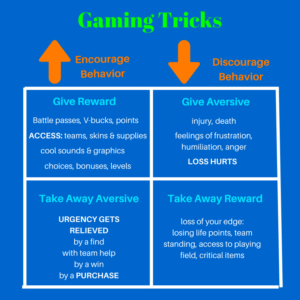I wrote this article for my awesome course – the GKIS Social Media Readiness Training Course for tweens and teens. I have to admit, I have never worked so hard on an article. The research took months. And explaining complex psychological principles in easy-to-understand language for teens was really hard. But it is now my favorite GKIS article of all-time. Here it goes…enjoy! We’re addicted to our screens, and it’s not an accident. Programmers intentionally bake hidden brain traps into our devices and onscreen activities to capture our attention…and our wallets. They’ve cracked the code on brain reward. With psychology research and protective legislation lagging behind rapidly developing technology, it’s up to us to understand what we’re up against. Learning how to recognize these manipulatively-designed brain traps can break the spell, interrupting our screen dependence and our spending. I’ve tested it on gamers in my practice. By teaching them how special features trigger dopamine in the pleasure center of the brain, gamers can be taught to recognize it as it’s happening. With this new awareness, many of them popped out of autopilot responses and found the games less enticing. If you teach your kids about the hidden brain traps of video games, will they change their addictive online habits?
What We’re Up Against

There are lots of screen activities that can addict users, but video games are among the strongest. They’re so fun and compelling that some gamers lose control and cannot pull away. In fact, gambling and gaming are the only addictive behaviors officially recognized by the World Health Organization and the mental health community.
Behind gaming is a huge profit. In 2019, 2.5 billion gamers contributed to a gaming market that made 152 billion dollars![1] The most successful game in video game history is Fortnite. First released in July 2017, gamers can download it for free on nearly every gaming platform. In just two months of being on the market, Fortnite was played 2.7 billion hours, the equivalent of 300,000 years.[2] Currently, it boasts 78.3 million players a month.[3]
Under Fortnight’s spell of perfectly programmed brain traps, I’ve had clients drop out of school and isolate themselves from friends and family to play 12+ hours a day. The most addicted can barely sleep, fail school, and become socially isolated and burned out. Some must be admitted to pricey screen addiction rehab programs that are often outside of their home states and away from their families!
What is it that makes video games like Fortnite so addictive?
Each brain is entirely unique with over 100 trillion synapses (the spaces between our brain cells where cell communication takes place). Not only does our DNA impact our brain wiring, so does experience. That makes learning a nature via nurture phenomenon. In other words, we seek out certain experiences because of our brain wiring, and our brain wiring changes in response to our experiences. No two people experience video games alike. Some people may be barely amused by the most addictive video game on the market, while others will forgo eating and sleeping in order to rack up points.
On the other hand, we are all human. We come from a common ancestry that developed with similar evolutionary triggers in play. As a species, we’ve been hunting and gathering for 200,000 years. Atari first introduced Pong in 1971. That means video games have only weighed in for the last .024% of our evolution. Find the triggers that captured the attention of our Neanderthal ancestors, and you’ll find triggers that capture us today. Programmers have done exactly that.
Operant Conditioning in Gameplay

Operant conditioning is a psychological learning method that involves rewards (pleasant) and aversives (unpleasant). The mechanisms behind reinforcement (increasing or encouraging behavior) are giving a player a reward or taking away an aversive. For example, a gameplay strategy is reinforced when the player is offered praise, prizes, or points – or when the player’s anxiety is relieved by getting a supply before another player.
The mechanisms behind punishment (decreasing or discouraging behavior) are giving a player an aversive or taking away a reward. For example, a gameplay strategy is punished when a player gets shot or points, supplies, or lives are taken away.
I know that is complicated. The easy way of thinking about it is that the double effect of feeling high when gaming and being relieved of uncomfortable anticipation is the double reinforcement also seen with drugs of addiction. Psychology research has demonstrated that addictive gameplay permanently changes our brain’s interpretation of rewards and losses.[9] The addict’s rewired pleasure center makes recovery very challenging.
Notice that the game traps described below work on these operant conditioning mechanisms. They train the player to play and spend. just as the developers intended.
Expert Video Game Traps Designed to Snare Your Attention & Emotions
Tribal Affiliation & Social Capital

One of the cornerstones of our survival as humans is our ability to form tribes and have babies. Through attachment and cooperative communication, humans dominate over other Earthly species. Gaming programmers know what makes us tick. They build games by testing them on themselves. By isolating and testing addictive game features, programmers combine the motherload of behavioral reinforcers.
Social feedback is one of those ultimate rewards. The likes and verbal and written comments from other players are like crack cocaine to the human brain. This is why the most popular games allow you to make new friends and invite others. The more influence we have, the more social capital we’ve earned.
Social capital, which is the collective value of all social networks, is particularly valuable to teens. It’s during this is the phase of development that one prepares to leave their family and hone-in on attracting their own tribe. By finding friends, testing skills, and “versing: each other, kids thrive on the team aspects of play.
Pairing with a stranger offers ample opportunity to test aspects of play without risk of losing social capital. Once new skills are attained, players increase social capital by showing off their new skills with their team. The emotional stimulation of wins and losses with your friends is extraordinarily captivating. As a young player told me, “Dying sucks and the team gets mad at you because they die too. If your friends are beating you, it makes you mad. So, you work to get more dubs (w for wins) in order to get bragging rights.”
Optimal Distinctiveness
Sexy curves and muscled skins are also valuable game commodities. By crafting the perfect look, players are able to attract other teammates. A tweak of an outfit here and an addition to your arsenal there, an improved display of fitness may be the difference between being perceived as a beginner or an expert. Psychologists call this the quest for optimal distinctiveness. In Fortnite, you can even earn the opportunity to be paired with other high-ranking and even celebrity players.
Learning & Expert Mentorship
Humans love to set, pursue, and reach goals. Learning through trial-and-error and tracking progress is deeply satisfying. Effortlessly learning from watching a YouTube celebrity streaming their gameplay is even better! Ask any iGen what they want to do when they grow up, and they’ll respond, “a YouTube influencer.” Celebrity endorsement as a branding strategy is illustrated by the popularity of let’s play videos (videos of other gamers playing and commenting on gameplay) on streaming sites like Twitch and Mixer.
Even players who haven’t reached celebrity status can make money from expert play. I’ve had clients play an account until they’ve leveled up, then sell these accounts for thousands of dollars to buyers who want expert-level access to features without having to put in the time commitment. Backchannel deals can also lead to big-earning e-sport tournament play. Some players even win college scholarships in tournaments that boast prize pools as big as 34 million dollars![4]
Hunting & Gathering > Building & Defending Community
For 90% of our history as humans, we were hunters and gathers – our first and most successful adaptation.[5] Just as our ancestors did, our brains delight in building and defending the community. Being a good seeker and warrior gave us an evolutionary advantage. Fortnite taps into these traits by having players forage for and gather useful, rare, and collectible items randomly placed around the map. Excited anticipation paired with finding items triggers our hunting and gathering instincts.
Fortnite also offers community competition and violence to scratch that primitive itch. Although parents are pleased there aren’t blood spatter and guts in Fortnite, developers know that tapping into our human need to protect and survive through violent in-group, out-group protectionism is a sure win.
Reinforcers that Appeal to the Senses

Not only are there evolutionary traps, but beautiful design, psychological reinforcers, and marketing techniques also keep us playing. Cool graphics, pleasing colors, attractive shapes, and amazing sounds stimulate the learning centers of our brains. When I asked my son what sounds he finds most appealing, he said the “kill” sounds are particularly attractive in Fortnite, especially the higher-pitched headshot sound and the sound of ammo reloading. My army of client gamers enthusiastically agreed.
The Near Miss Effect
Getting a victory royale in Fortnite is difficult. Players must have the skill and luck to defeat other competitors in battle. Most gamers play multiple, consecutive rounds without getting a victory royale because, in their minds, they are not failing, they are “almost succeeding.” In psychology, this is known as the near-miss effect. A gambler experiences a near-miss when almost winning a hand in poker. They take it as a sign to continue playing. During a near-miss, the brain’s reward system activates the same way it would during a win.[6] Earlier generation Candy Crush game developers learned that the near-miss effect kept players hooked for hours and willing to spend.
Variable Ratio Schedule of Reinforcement

Another addictive gameplay mechanism that keeps kids playing is the release of rewards on a variable ratio schedule. The same schedule programmed into Vegas slot machines works by providing a reward after a changing number of responses. For instance, when playing a slot machine your goal is to get the jackpot. You know that each time you play you have a chance at getting the jackpot, so you continue playing even after losing multiple times. Fortnite players get the chance to win multiple jackpots every round in the form of rare items. It also offers weekly challenges for a free skin. By unlocking a majority of weekly challenges (55 of the 70), you unlock another free skin. With immediate and long-term rewards, the game traps the immediate reward players and the work-for-it reward players.
Novelty and Free Gifts
To stay successful, games need to bring in new players while keeping the attention of seasoned players. Building anticipation for something new and exciting with a free gift is a sure way to hook and keep customers. Upon signing up for Fortnite (which is free and convenient), players are offered a starter bundle. Once you get tired of that, more anticipation is generated with the promise of another free gift with repeated seasonal battle passes which contain prizes like free skins, a pickaxe, a glider, and some XP multiplier to level up in the game. Each season offers a new map and fresh features to avoid burnout. To reinforce habit and daily use, Fortnite even offers cash if you log in on consecutive days!
Scarcity Creates a Sense of Urgency
In 2018, Fortnite made 2.4 billion dollars in revenue.[7] Most of this revenue came from players purchasing skins and emotes. As of January 2020, Fortnite is currently in its first season of Chapter 2. Chapter 1 had ten seasons. With each season comes the release of new skins and emotes, as well as the removal of ones from past seasons. Removing products from the marketing creates an impression of scarcity – meaning if you don’t buy now you’ll lose out. This makes collecting and purchasing skins and emotes a high priority to players, as it signifies status within the gaming community.
Triggering a sense of urgency in players is highly motivating, anxiety-producing, and builds intensity. Finding that sweet spot of flow between boredom and anxiety is the quest of every gamer. Once again, Fortnite doesn’t disappoint. The sense of urgency while searching and release upon finding creates a feedback loop of needing more, more, more! Being online puts us in a perpetual state of want.
Player Enthusiasm Recruits More Buyers
Fortnite knows that watching friends have fun triggers our FOMO (fear of missing out). By jacking up player anticipation with live online events, Fortnite gets players advertising to their friends for free. To attract big numbers, Fortnite offers exclusive information and items. In other words, gamers must attend to get a chance to see what’s coming and get access to cool stuff. Kids prioritize these events to get a leg up with their team members.
Upsell
Purchasing a common emote or skin costs $8, and the cost of a rare emote or skin is about $20. Marketers call higher-priced in-game options offered once the player gets used to being a customer an upsell. Fortnite in-game purchases can be very expensive. A father from England found out when his son spent $918 on the game in three days![8] Fortnite is a virtual marketplace that is very enticing to immature brains.
Affiliative Marketing With Brands & Experts
Fun products that tie into popular brands, like The Avengers, are also integrated into the game. This is called affiliative marketing, which allows brands to partner and benefits from each other’s userbase. Celebrity skins, affiliation, and team competitions sweeten the offer even more. By going onto the same Discord server and coordinating a game with other players, gamers can join a scrim (short for scrimmage, it refers to a practice match) or a snipe (a big group of players joining the game). There are also customized matchmaking keys for pro players. If you don’t have the time to earn v-bucks through hours of play, you can pay. Fortnite offers scrims with a $30 million world cup prize!
Issues Specific to Neurodivergent Players
Neurodivergence simply means players who think differently than the average player. Most commonly, it refers to people who have traits of autistic spectrum disorder or attention-deficit hyperactivity disorder. All players have gameplay strengths and weaknesses. But for neurodivergent players, these strengths and weaknesses can be more extreme. For instance, many neurodivergent players have a tough time making and keeping friends in real life. For them, the opportunity for online mastery and social capital is particularly valuable. And the cool thing is, some strengths typical of neurodivergent players, like pattern recognition, make them awesome gamers. One of my clients who has autistic spectrum disorder describes loving the problem-solving elements of gaming and the thrill of earning accolades from her teammates for her exceptional Jedi skills.
Try it Out Tonight
Most of my clients insist that Fortnite is on its way out. Does that mean we no longer have anything to worry about? As long as the video game market continues to pull in a huge profit, developers will continue to build games with increasingly sophisticated brain traps. Going screen-free is not an option for most because of the extraordinary learning, communication, and socialization benefits that screens bring.
By reviewing this article with your gamer tonight, covering the points where you agree or disagree, and asking them for their thoughts and observations, you will empower your child through parent-child connection. Protecting your kids is less about depriving them of screen time, and more about giving them the tools they need to have informed agency. By equipping our children to be smart problem solvers on- and offline with loving support, we open the bridge to really connect as a family. It’s the connection that our children are looking for, and we are a part of that.
If you would like to help your child build psychological resilience and better coping with social media and video game use (or prepare them for their first social media app), you won’t want to miss our GKIS Social Media Readiness Training Course. Complete with lessons about digital injury risks and psychological wellness tools and individual lesson mastery quizzes, it’s the perfect prep!
I’m the mom psychologist who will help you GetKidsInternetSafe.
Onward to More Awesome Parenting,
Tracy S. Bennett, Ph.D.
Mom, Clinical Psychologist, CSUCI Adjunct Faculty
GetKidsInternetSafe.com
Works Cited
[1] The Global Games Market Will Generate $152.1 Billion in 2019 as the U.S. Overtakes China as the Biggest Market
[2] Mansoor, Iqbal (2019) Fortnite Usage and Revenue Statistics (2018) http://www.businessofapps.com/data/fortnite-statistics/#2
[3] List of video games by monthly active player count
[4] https://www.esportsearnings.com/tournaments
[5] Lee, Richard B.; Daly, Richard Heywood (1999). Cambridge Encyclopedia of Hunters and Gatherers. Cambridge University Press. p. inside front cover. ISBN 978-0521609197.
[6] Jamie, Madigan (2016) The Near Miss Effect and Game Rewards
[7] Matt, Porter (2019) How much money did Fortnite make in 2018? https://www.dexerto.com/fortnite/how-much-money-did-fortnite-make-in-2018-285995
[8] Joe Pinkstone (2018) Distraught father issues a Fornite warning after his son, 12, spends nearly £700 on the violent game in just three days https://www.dailymail.co.uk/sciencetech/article-5874041/Father-discovers-son-12-spent-nearly-700-three-days-Fortnite.html
[9] Dong, G. Hu, Y., & Lin, X. (2013). Reward/punishment sensitivities among internet addicts: Implications for their addictive behaviors. Progress in Neuro-Psychopharmacology & Biological Psychiatry, 46, 139–145.
Photo Credits
Photo by Alvaro Reyes on Unsplash
Photo by Sebastian Pociecha on Unsplash
Photo by Eddy Lackmann on Unsplash


